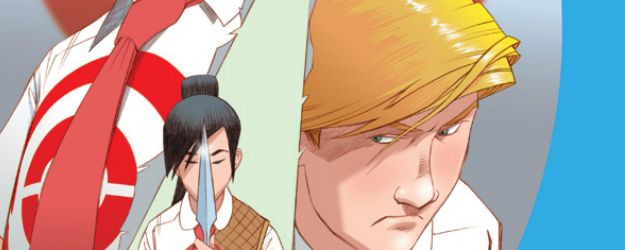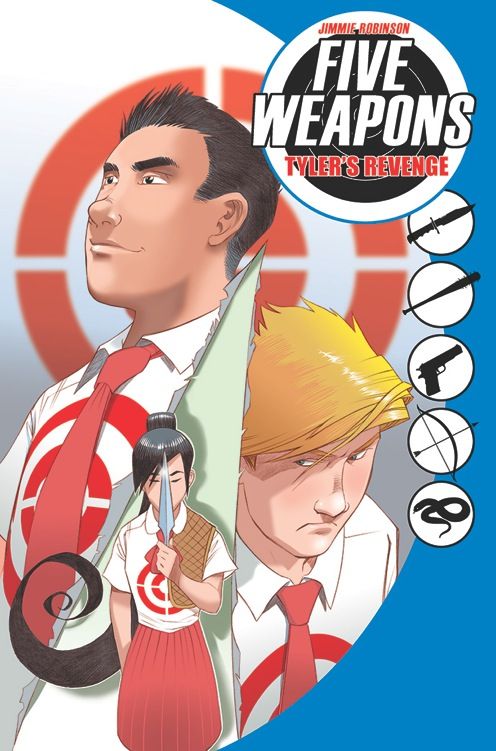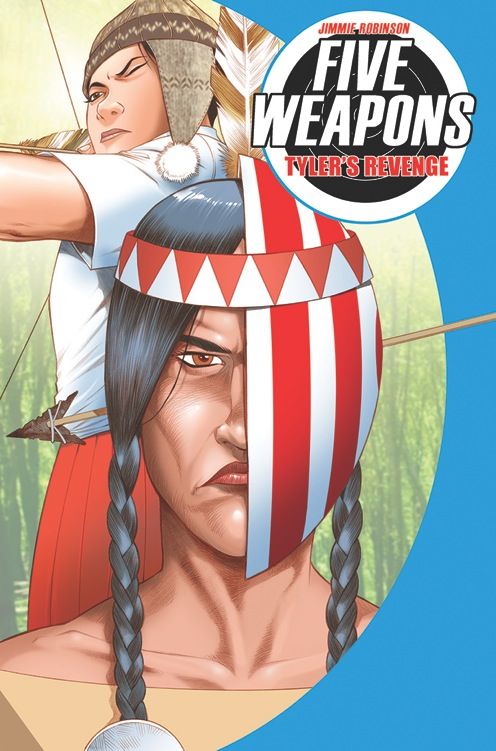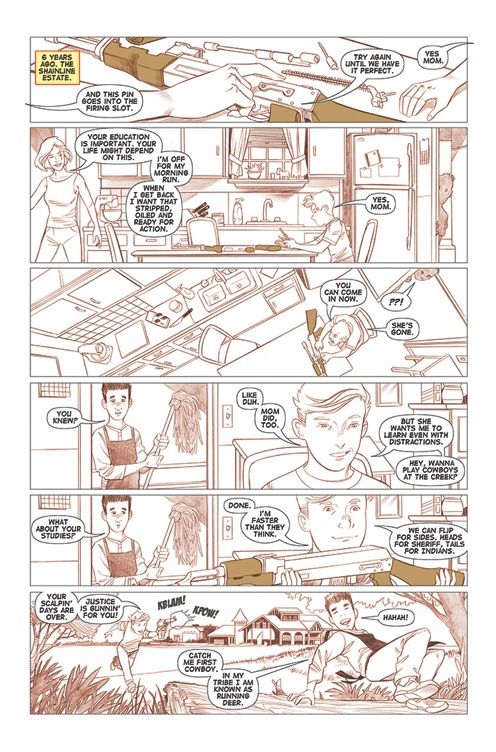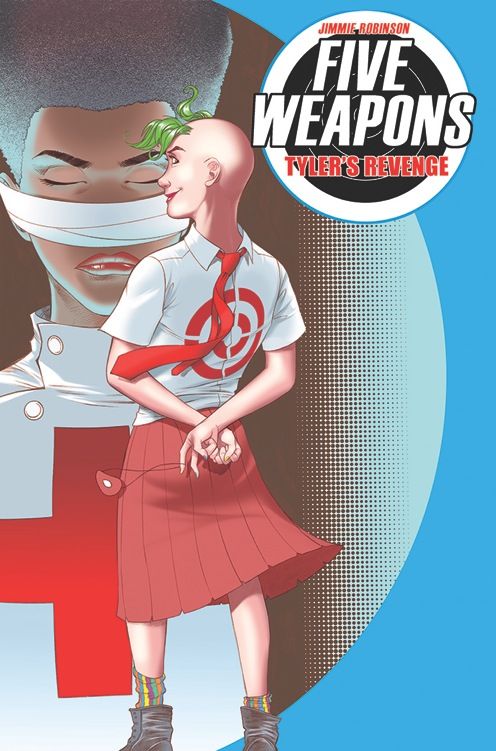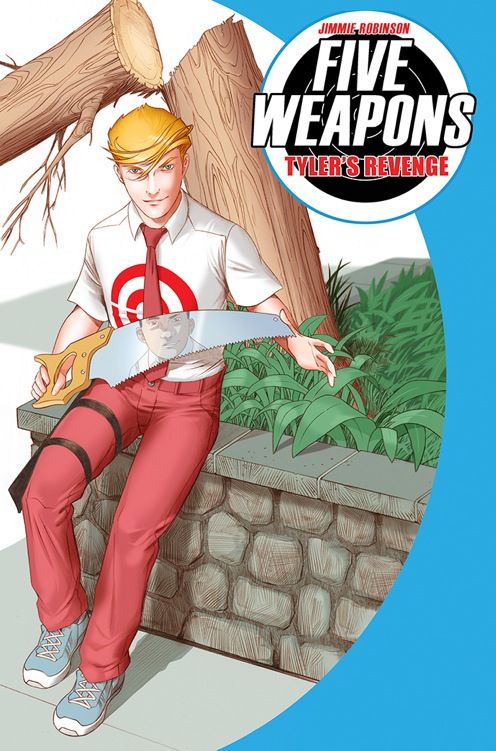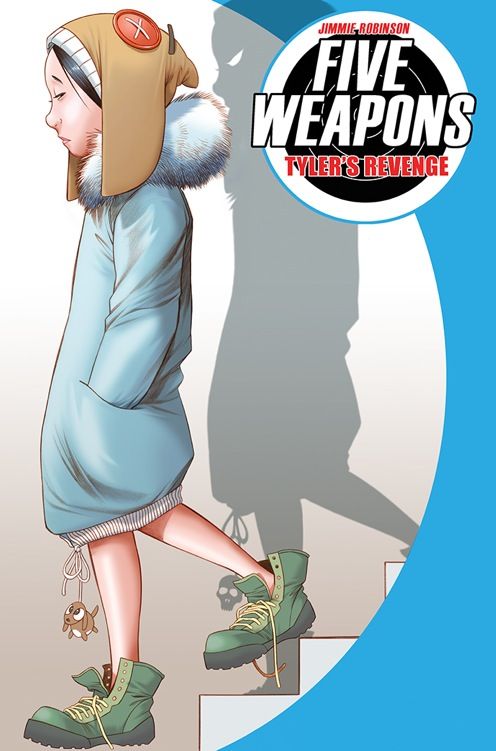Writer/artist Jimmie Robinson has been creating and publishing his stories through Image Comics for almost 20 years. Let that just soak in for a moment. Wednesday marks the resumption of Five Weapons, his now-ongoing series set in a high school for assassins, which launched as a five-issue miniseries, but it performed so well that Jim Valentino's Image imprint Shadowline offered to make it a monthly.
In addition to discussing the transition from miniseries to ongoing with this week's Issue 6, Robinson agreed to discuss the recent Image Expo and his larger industry realization that the loss of Dwayne McDuffie left a hole that has yet to be filled. He also addresses his intentions to return to the Bomb Queen universe as well as whether he would ever write for Marvel (in particular Rocket Racer) or DC (think Chase).
As part of the Five Weapons coverage, Robinson shared several upcoming covers, plus one in-process page from Five Weapons #7. Be sure to answer the question that Robinson poses at the end of this interview in the comments section.
Tim O’Shea: When you started Five Weapons as a miniseries, did you have any expectations that it could grow into an ongoing series?
Jimmie Robinson: Not at all. Shadowline was originally created by Jim Valentino as an Image studio for new ideas, and often those ideas were pitched as miniseries, so I kinda got that stuck in my head. When I pitch a new idea to Shadowline I pretty much think of a story with a beginning, middle and end. I’ve been with Image for about 20 years. I have several books and series under my belt, so I’m used to creating a series, finishing it and going on to the next. So I had no expectation of it turning into an ongoing series.
Did you have to make adjustments to the narrative of the miniseries to make an ongoing work?
Yes. It was around issue 3 or 4 when Valentino offered Five Weapons to just keep going. So I made some changes to Issue 5 and created the connections that would make it flow naturally from Issue 1 to the now ongoing series. The basic platform is still the same. Enrique is a pacifist who doesn’t use weapons in a high school of assassins, but now that I have the legroom of an ongoing series, I can build on top of that and expand into the wider world of Five Weapons.
In the first five issues, you introduced a slew of characters quite effectively. Now that you have settled into an ongoing, how much do you plan to work with the cast you have versus introducing some new characters into the mix.
I want to work on the core cast because I think their introductions were a bit short in the miniseries. At the time I only had five issues to make it all work. However, I don’t want to spin the same story over and over now that the series is ongoing. That’s why I'm introducing new characters and situations. Keep in mind that this is all new turf for me: My books usually deal with a single lead character, but Five Weapons is a bit like a sitcom with a cast. I’m still learning the ropes, but in my opinion a good ongoing series is about good ongoing characters. I can continue to make wild and crazy plots and concepts, but readers will follow a character they care about through thick and thin. Obviously a good book involves all elements, so I’m juggling a lot of pieces right now to keep the readers entertained and at the same time keep them guessing at every cliffhanger. And yes … I will continue to have a cliffhanger at the end of every issue.
Speaking of the existing cast, while Enrique Garcia is the star, who did you realize over the course of the miniseries that you really looked forward to utilizing in future issues?
There are two characters that I really wanted to dig into in the mini-series, but time and page space didn’t allow it. The Archery Club teacher and the school Nurse. The archery teacher, Miss Featherwind, has a weird backstory, and I’m often asked about her when I go to conventions. She has an arrow through her head and wears a mask that covers half her face. While it is a good visual gag, it is there for a reason. I get to explore that in depth in Issue 8. It will be a tightwire rope to pull it off, because I’m dealing with Native American Indian stereotypes and her backstory at the same time. The school Nurse is actually involved in one of the plots in the new story arc, so through issues 6-10 we will learn her backstory and a much larger piece to the world of Five Weapons -- beyond the school. That is very exciting for me as a writer. However, at the core of it all will still be Enrique Garcia. He will be key to the upcoming master story arc.
Who is coloring you on Five Weapons?
Thank you for asking, because this book would not be where it is without the work of Paul Little. I wanted Five Weapons to be different and look different. Paul is doing a lot of work that some folks may not even realize. He’s using a limited color palette and making it work. I didn’t want the standard comic coloring for this series; in fact, I was tempted to only use two colors in a weird watercolor wash. I was thinking pastels with extremely light hints of color. Nothing deep or dark. I was concerned about it looking too serious instead of fun and inviting. However, those were all extreme ideas. Thanks to Paul, the book has found a happy middle ground. The colors are limited, but he’s worked his magic to create new variations issue after issue.
Also, I give Paul very little color direction. He’s been with me on Bomb Queen for a long time, so we work well together. I pretty much let him know if it’s a bright day, nighttime, cloudy or if there’s a specific item I’d like him to focus on. Five Weapons is built on solving mysteries, so some clues are either colored of highlighted in unique ways. Paul is good at what he does; he’s a professional and not a weekend warrior. He has dedicated his career to coloring and I’m fortunate to have him onboard — before Marvel or DC snatches him up.
This year you were unable to attend Image Expo. CBR columnist Allison Baker wrote a column acknowledging that Image Comics is replete with female creators as well as people of color, but the perception was quite different when photos emerged from this year's expo. As Allison put it, "'That's a LOT of white dudes.' I said to myself." What are your thoughts on the need for comics publishers (not just Image) to present and maintain an image of diversity, in creative talent as well as characters, that are published.
This has generated a lot of talk and comments from various sides and positions. I’m glad that Allison recognized the wealth of diversity in the wider range of books at Image, mine included. However, at the expo what we saw were newly announced books from the top cream-of-the-crop creators -- not just the top creators at Image, but in the comic industry. That’s the takeaway we should all remember: that Image scored some great deals with some great creators and set the pace for 2014. It’s gonna be a solid year for Image. Nonetheless, people wonder why we didn't see much diversity on that stage. Well, first off, if Image featured every book they were currently printing, then the expo would have been a week long. Second, I want Image (and any publisher, for that matter) to print good books, not books for per quota. Third, Image is a moving target; it’s constantly evolving and recreating itself. What we see today is not what we will see next year, just as last year we didn’t see these new books coming this year. So, even if that stage looks skewed it’s only for a moment. I only hope that when new people step up on the stage that Image doesn’t get reverse accusations of pandering for quotas. Image doesn’t check your race at the door. The question is why aren’t more people stepping up to the door in the first place?
Which brings us to the wider front: This won’t be solved overnight, and if you ask me it won’t ever be solved where we can stamp it “done” and walk away. Diversity is a problem in several industries, not just comics. If publishers want more market share that include a diverse demographic, then they will have to find ways to get their books into regions and markets where those people are — thus, publishers might inspire new people to join the industry. Jamal Igle and Rob Guillory have talked about the door of opportunity not even on the radar to most people, the understanding that less people will attempt to create content because they have no idea they’re even allowed in the club. This is true to an extent, but it’s not like comics are hidden away in a whites-only vault. Comics are out there, stores are out there, she Internet is out there, the movies and TV shows are out there. The conventions in almost every state of the union are out there. Yet many people of color, women and gays don’t think they have a place at the table. Why? Some people think if comics reflect those markets then it will inspire others to step up. In short, not make all comics about white males. Whatever a publisher decides to do is up to them. If they want to champion the cause of diversity, that’s fine. Bring on Milestone 2.0 make Spider-Man and Nick Fury black or whatever. OR … if they want to continue to make good books -- by anyone -- then that’s good too. What I say ... and this is my tough love coming in … is that we are just not there yet. Period. Full stop. So stop dreaming about it and start working on it. What we have is a diverse base in the comic industry, but the top 10 percent doesn’t reflect the width of the industry. Even if say you get a creator of color who can garner around 100K in monthly sales that would only be one person. We had Dwayne McDuffie, and he left us too soon. And now he left a hole. But patching a hole at the top isn’t the solution to the general problem. So honestly, I don’t have an answer to this because the movement to make an industry-wide change hasn’t happened yet. And in my opinion I don’t see it as a revolution and surrender, but more of an integration and acceptance. That won’t come from the top down, that comes when enough people bring it from the masses. The readers and the publishers together. That’s when diversity works naturally.
Speaking of diversity, the cast of Five Weapons is like a model U.N., with a variety of races and a nice balance of female and male characters. In terms of race, how much research did you need to do in trying to properly represent the characters?
Thanks for noticing. I wanted to pull characters from around the world because it makes for great conflict and character development. Also, some weapons are well known for their country of origin, like the Katana from Japan, or the AK-47 machine gun from Russia. As for race and gender, I wanted to show how weapons can be used by pretty much anyone, no matter their race or gender. I didn’t want all the members in the Gun Club to be Rambo types because I wanted every character to have a reason for using their gun. That way Enrique can dissect each character instead of fighting against the weapon. It’s also good fun to turn stereotypes on their head. The president of the Gun Club, Nat the Gat, is a Hassidic Jew who just wants to make his family happy. The president of the Archery Club, Darryl the Arrow, is a brainy nerd who runs the school paper and aspires to be a journalist. One of my favorites is Dennis. He’s a Sikh from a poor village in India. And in Issue 8 we see more of Hannah, who comes from the mountains of Nepal. I do a lot of research on the characters, because often their country and culture will help Enrique solves mysteries and figure out clues.
In the CBR review of Issue 5, Greg McElhatton wrote, "Robinson manages to tell the entire story using only horizontal panels stacked on top of one another; it's a format that could have proved to be limiting, but Robinson makes it work even with tight zoom-ins alongside large vistas. When Vera attacks the school, I like how he uses that close focus to show her attacks rather than lots of large, expansive images. It lets us concentrate more on what she's doing and avoids the more obvious, less interesting way to show us." In terms of the layout of Five Weapons, did you make a conscious choice to do tight zoom-ins, due to the weapons use?
Comics are brilliant in that create movies in the mind of the reader. We get images and text and simulated movement in time and space. We get the same effect from TV and movies. However, the difference is that comics tend to be very extreme in how the stories are represented — based on the rules in how we read them. We have splashes, montages, wide and short panels, etc. But when we watch TV and movies, the screen size never changes, so I thought … why can’t comics do this? This isn’t the first time I’ve used this method. I did a book for Image Comics back in the 1990s called Code Blue. It was a hospital drama much like Gray’s Anatomy -- just a drama with some romance, nothing more. There was no need for explosive panel layouts, so I did all horizontal panels. In Five Weapons I made the conscious decision based on several things. I want the story to run quickly, like a rush. Thus, the fastest way down the page is a straight line instead of left to right. Also, when folks read a comic page their eyes often skip around the page in a very quick scan. I think that sometimes ruins a surprise effect. Also, and this is a new thing for me, when people read the book in digital format on a tablet or computer and they use the guided view on comiXology the reading experience is more consistent because the width of the panel is always the same — just like with TV and movies.
As for the content in the panels, such as the zooming in and playful use of the camera view … that’s just me trying to make a scene of talking heads into something unique. Five Weapons has action, but there’s also what I call the “parlor talk" -- that time when Sherlock Holmes gathers all the suspects in a parlor room and tells them who the murderer is and how he caught him. While that can be entertaining in prose it is kind of lame in comics. So I move the camera eye all over the place, above, behind, reverse, pulled back and zoomed in. I think it’s emphasized even more because of the horizontal layout. And trust me, that layout has nearly killed me. We still read comics left to right, so positioning of characters and word balloons and action have to all dance in concert. It can be tough, but at the same time it’s a fun storytelling device because it turns you into a cinematographer and choreographer. The action and focus must happen in front of the camera’s eye. It’s like watching a scene through a mailbox slot or a story told with a puppet theater box.
With Five Weapons as an ongoing, are you taking a break from the Bomb Queen universe for a while?
Just a little bit. I want to revisit Bomb Queen, but the cross I bear is that I just love to write and draw my books. This means I have so little time to do anything else, or multiple books. So right now I’m doing Five Weapons. When I get back to Bomb Queen it will most likely be a one-shot special unless I develop a story idea that needs the miniseries treatment. I’ve considered someone else writing it or someone else drawing it … but then I come back to reality when I consider how I make comics. I would drive a collaborator insane. I write, and draw and correct and change so much stuff just before press time that most folks would just walk away. Sure, I can write a complete script for another artist. In fact, I do that all the time for myself. However, because I tend to write for myself I can also make last-minute changes. And I’m talking about massive story direction changes. So yeah, I’ll get back to Bomb Queen, but since I like to be a one-man army it means only one battle at a time.
What I plan to do in 2014 is at least start the ball rolling on another book while I do Five Weapons. I can easily write two books. I did that when I worked on Bomb Queen Vol. 4 while I also wrote a Wolverine story for Marvel. I just can’t write and draw two books at the same time. However, when it comes to Bomb Queen I also want to do both, because half the fun is the city and backgrounds in that series. A lot of that crazy stuff comes directly out of my head right to the art page. No script can ever convey that on paper.
Would you ever consider having guest artists on Five Weapons, or is this always going to be a series you want to write and draw?
Five Weapons and Bomb Queen share the same space in my mind, so I would continue to write and draw both of these books. There are things that developed in Five Weapons that never appeared in the script. In Issue 1, there’s a weapon on the wall from the video game Final Fantasy 7. The same weapon appeared, along with a character, in Issue 5. And now we’ll see that character and weapon come to life and be part of the story in Issue 10. The same for a side character in Issue 2, who becomes a plot point in Issue 7. These were, at the time, just tossed out ideas and on-the-spot character designs, but in my mind they grow in ways that could never be written in a script. My creative mind is a trap like that.
You mention you would be willing to write another project, but not draw. Any chance you might do something for Marvel, DC or one of the many other non-Image publishers? Or if you do any writing, will it be for Image?
That’s a good question. It depends on the title and what I’m allowed to do. I did a book for Marvel’s What If? (Wolverine), and while it was fun I was still boxed in a bit because of the character’s high profile. So if we’re talking about Marvel or DC, then I’d like to work on a lower-tier character where I could revamp the title. Much like what Matt Fraction did with Hawkeye, or what Kieron Gillen did with Young Avengers. That would get me over there, but in the same breath it would be tough because I can’t see myself doing that for very long. Also, and I have to bring it up, I won’t own it. Don’t get me wrong, I don’t mind working for Marvel or DC, but not on something that would tip my balance into their sandbox and away from my creative ownership that I have at Image. But … if I was pressed to say what Marvel character I would like to work on, I’d say Rocket Racer. No, seriously. Give me Rocket Racer. I’m black. Check. I used to skateboard for 15 years. Check. I write comics. Check. I can do that. When I was a teenager I made a comic with my own skateboarding hero. I even made a comic with that hero fighting the Teen Titans. Hahahah! The problem is, I would love to draw it, or at least draw the covers and draw a redesign on the costume. If asked about a DC character it would have to be Chase. I loved that series, and I hated to see it end. Which brings up the other problem I have with working at Marvel or DC: They don’t experiment enough, and if a title doesn’t sell well it often gets canceled. It’s hard to grow an audience over there.
As for working with other publishers like Dark Horse, Boom, Dynamite, IDW, Oni, etc.? I would be open to that, but it depends on the title. Writing for superheroes comes with a level of understanding the platform and structure, but with other publishers the genres are wide open. So it depends on the title and my personal interests in the subject. I’m not good at writing what I’m not interested in — which is something I need to work on. A good writer, in my opinion, can grasp at that one straw and turn it into gold. It would be hard for me to be a fill-in writer on someone else’s book.
As for writing something else at Image? I would like that. I’m comfortable at Image and we have a history. The beauty of Image is that I can play with ideas even if my book isn’t doing so well. Obviously if my work drops into the red it will get canceled, that’s the right of any publisher. My books usually sell in the low range, on the bottom of the Top 300 (and beyond), but Image is happy even if my books are barely profitable, and they trust me to bring unique content to the readers. However, if I was at Marvel or DC with a book in the single digits there’s a high chance it would get canceled on the spot without my consideration, or they might wiggle in a cameo with a popular hero to boost sales. In my view, a book doesn’t have to be a major event tie-in or a record-breaking cross-promotion that makes it on the evening news. We also need books to create that diversity on the shelf for folks who just want to pick up a fun title with a different attitude and style. Yes, the numbers are lower than the audience for the Batman books, but those are still readers. They still deserve a book for them. They still deserve a choice.
Any questions you want to pose to ROBOT 6 readers?
If you had to choose a comic for your 10-year-old brother or sister, what would you pick? And why?

